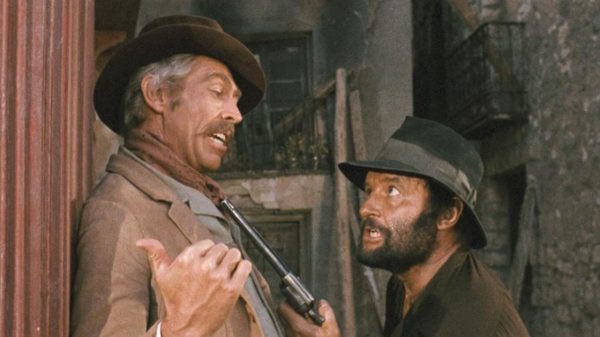 I couldn’t believe my eyes when I saw the TV listings. At 2:05 a.m., TBS was airing a movie called “A Fistful of Dynamite,” a Sergio Leone Western I had never heard of. When Clint Eastwood Week would come around every six months on Denver’s local UHF channel I would dutifully watch all three Man With No Name movies, and I had later discovered the epic “Once Upon a Time in the West.”
I couldn’t believe my eyes when I saw the TV listings. At 2:05 a.m., TBS was airing a movie called “A Fistful of Dynamite,” a Sergio Leone Western I had never heard of. When Clint Eastwood Week would come around every six months on Denver’s local UHF channel I would dutifully watch all three Man With No Name movies, and I had later discovered the epic “Once Upon a Time in the West.”
But “A Fistful of Dynamite”? What was that?
I wasn’t sure what to make of the movie when I first came across it almost 30 years ago (and, given the start time, probably didn’t make it that far into before nodding off). Rod Steiger as a sort of Tuco knockoff, chewing up the scenery with glee. James Coburn with a soft brogue as an ex-IRA bomber looking to ply his trade in the Mexican Revolution. The tone was jaunty, yet melancholy at the same time, perhaps the slowest paced film that also features huge explosions.
People still aren’t sure what to make of “A Fistful of Dynamite,” now out on Blu-ray from Kino Lorber, starting with what to call it. Leone originally wanted it called “Duck You Sucker,” an inelegant translation of an Italian expression that roughly means “Keep Your Head Down” (a much better title).
But that title didn’t fly with U.S distributors, who renamed it in a sloppy attempt to tie it to “A Fistful of Dollars.” The French gave it a very strong title “Once Upon a Time . . . The Revolution,” which both captures the film’s almost fairy-tale like quality and makes it a connective bridge between “West” and 1984’s “Once Upon a Time in America.”
And then the running times are all over the map, with different versions playing in different countries. Some distributors cut out some slow passages in attempt to pick up the pace, others cut out objectionable content. But almost all agreed that the film’s strong political content had to go; what kind of Western starts with a quote from Mao Tse-Tung?
““A revolution is not a dinner party, or writing an essay, or painting a picture, or doing embroidery; it cannot be so refined, so leisurely and gentle, so temperate, kind, courteous, restrained and magnanimous. A revolution is an insurrection, an act of violence by which one class overthrows another.”
The Kino Lorber version is the definitive 157-minute one, a very odd epic from Leone that is his most overtly political and relevant film, commenting on the turbulent state of Italian politics at the time through the lens of the Mexican Revolution. Steiger plays Juan Miranda, an amoral outlaw in 1913 Mexico who robs stagecoaches with the help of his many sons. In the opening scene, Juan infliltrates a luxury stagecoach, where the rich and powerful wolf down food and drink like animals (in nauseating close-ups) while pontificating on the “savagery” of the working class. The pump is primed for revolution.

Juan meets up with John Mallory (Coburn), and sells him on the idea of using his gift with explosives to rob a bank in Mesa Verde. John goes along, but the joke is on Juan; the bank has been emptied of funds and turned into a prison for revolutionary leaders. Juan and John are proclaimed as heroes of the revolution, but as Mao says, this is not a dinner party.
In some ways, “Dynamite” reminds me of Tuco and Blondie wandering across the landscape of the Civil War in “The Good, the Bad and the Ugly,” seeing again and again the folly of war. But “Dynamite” is even bleaker, full of scenes of revolutionaries being executed, sometimes dumped in mass graves. One scene, in which Miranda discovers dozens of dead bodies – including his entire family – in a cave, is meant to echo a real-life massacre that Italian audiences would remember.
Leone was casting a dim view of the leftist politics of the day; he’s likely using Juan as his mouthpiece in his famous tirade about the relationship between the poor people and “the people who read the books” – the people who read the books call for revolution, and the poor people die in it. What matters to Leone is not devotion to a cause, but devotion to family and friends. The unlikely friendship between the boisterous Juan and the sly John is quite moving, the first real male-on-male friendship in a Leone movie.

Steiger’s performance as a Mexican outlaw feels a little too mannered to me, especially in contrast to Eli Wallach’s Tuco. But Juan’s floridity is a nice contrast to Coburn’s understated John, whose dazzling grin conceals a lot of pain and guilt. The soft-focus slow-motion flashbacks to John’s memories of idyllic Ireland, and a love triangle that ended in betrayal, add a layer of poignancy to his character.
“Dynamite” features some of Leone’s most ambitious shots to date, involving hundreds of extras, including a climactic night battle between revolutionaries and military, lit by the glow of a derailed train on fire. But, in contrast to the jaunty poster featuring Juan behind a machine gun and John looking like a Spy vs. Spy character with an overcoat stuffed with dynamite, the film is much more somber than advertised.
“A Fistful of Dynamite” is Leone’s most overlooked film, and many of those who have seen it haven’t seen it in the original uncut version. I don’t know if it would be anybody’s favorite Leone Western, but its strangeness and its complexity, and its unexpected sadness, makes it essential viewing.